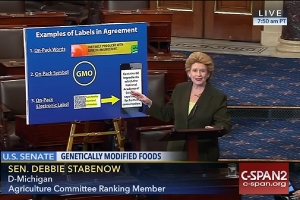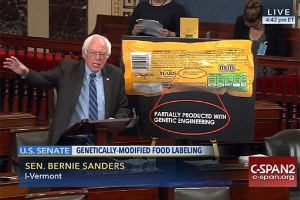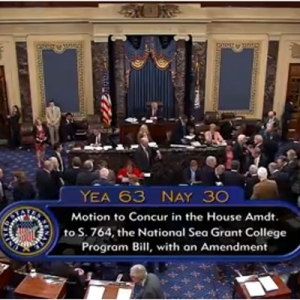
On Thursday, July 7th, the US Senate passed a bill that would set a national labeling standard for foods containing genetically engineered (GMO) ingredients. Introduced by Senator Debbie Stabenow (D-MI) the previous day, S. 764 is a compromise bill that resulted from negotiations between Stabenow and Senate Agriculture Chairman Pat Roberts (R-KY), which had already drawn heated debate between partisans of this issue. At the end of the first day, the Senate voted 65-32 for cloture on the GMO labeling bill, thereby limiting debate and discussion of amendments. On Thursday, the bill passed with 63 votes in favor, and 30 votes against. If a similar bill is passed in the House of Representatives, this standard could become law in the United States.
Since the introduction of genetically engineered crops, the question of labeling them in stores has been a contentious political issue, but one that did not often rise to national consciousness. Several waves of ballot measures had been attempted by proponents of labeling such as California Proposition 37 – but every one of them rejected by voters. Some of the smaller, northeastern states of Vermont, Connecticut, and Maine passed mandatory labeling laws through their legislatures, as part of a multi-state approach taken by advocates (map). All but one of these states had a conditional clause stating that a certain number of nearby states with large populations must also have GMO labeling laws for theirs to take effect. Vermont is the only state that has a labeling law without such provisions, and it went into effect on July 1 this year. Some companies have already added labels to their packages. (Read our story about some of the initial effects of this law on food availability in Vermont here.)
Some lawmakers, looking to avoid some of the costly and problematic effects of a single state mandating special labels on foods sold within the state or a potential state-by-state patchwork sought to propose laws that would pre-empt state labeling mandates and replace them with a single federal standard. One such bill, proposed by Senator Roberts, would have put the USDA in charge of creating a voluntary labeling standard, (which is discussed in detail here) but failed to pass. Other senators, such as Jeff Merkley (D-OR) proposed a mandatory GMO labeling scheme that was more stringent, which also failed to gain support. Senators Stabenow and Roberts together negotiated a compromise bill that became the one introduced Wednesday, and passed Thursday.
The bill institutes a national mandatory labeling standard for foods that contain genetically engineered crops, with several options for how food manufacturers can label their products. They can use plain language on the package, a website url, phone number, or QR code that leads to disclosure about GMO content, or a symbol that would be created by the USDA after a 2-year process. The bill also grants authority to the USDA to determine the accessibility of the QR code based approach as well as some of the bills exemptions. “Very small” companies do not have to disclose this information, and ingredients that do not contain genetic material from the crops they were derived from are also exempt. Even with these exemptions, compared to the Vermont law it replaces this results in thousands of additional products that would be covered.

Upon introduction into the Senate, Senator Stabenow emphasized that there was no scientific controversy over the safety of growing and eating genetically modified foods. The Vermont label law H.112 actually contains language stating that “There is a lack of consensus regarding the validity of the research and science surrounding the safety of genetically engineered foods” as justification for enacting the law. While Stabenow was still giving her presentation introducing the new bill, A small group of senators including Bernie Sanders (I-VT) held a concurrent press conference voicing their opposition to the bill and re-emphasizing issues such as safety and their concerns about corporate power. The debate continued through the following day, and viewers reported that Senator Sanders chastised the Senate for not inviting “all voices” to testify in the Senate about GMO safety, and that Senator Stabenow dismissed popular conspiracy theories about GMOs, citing the recent National Academy of Sciences report on the subject.
In the final vote tally, among the 63 yea votes were 41 Republicans and 22 Democrats, indicating strong bipartisan support. Since this bill differs too much from HR 1599, the Safe And Accurate Food Labeling Act of 2015 which spelled out a voluntary GMO labeling program, there will need to be a new bill passed in the House of Representatives before this bill can be brought before the President to become law. In the meantime, the contentious debate about whether and what kind of labeling there may be for genetically engineered foods in the United States is sure to continue.

Videos
C-SPAN2 Day 1 Part 1: Introduction of S. 764 to Senate
C-SPAN2 Day 1 Part 2: Advancement of S. 764
Youtube Live: Press conference of senators opposed to S. 764
C-SPAN2 Day 2: Debate and final voting on S. 764
Since it is very clear that those who want to use GMO labels on food products to further their fear campaign will never stop until there is some type of GE labeling, this is probably the best we can hope for. This bill allows for much more information on how food production is done and why GE crops are so popular with farmers. It also makes it very difficult for the fear marketers to use the symbol or Federally chosen wording to continue their fear campaign. So all in all a win for consumers and a huge setback for the anti-GMO industry.
LikeLike
The important difference that the QR codes/phone/URL option provides is enabling food producers to engage in conversations with consumers on their own terms, allowing them to give the reasons why they use GMOs. The NY Times completely missed that when they said that the “only” reason to have these is to hide information. The industry can be responsive and flexible, and it takes the wind out of the label-to-ban movement.
LikeLike
It also opens up whole new avenues of marketing for the manufacturers. An advantage that non-gmo and organic cannot ignore. Hence, all, sooner than later, will have QR codes.
LikeLike
Funny about Merkley. If he was a supporter of states’ rights, shouldn’t he be working against labels? Voters in his state rejected labels.
I still don’t support mandatory labels. In the interest of compromise, though, I’m not working against this. But I am kind of enjoying watching team label lose their minds. And that suddenly people are realizing what the real goal was:
LikeLike
States Rights:
From Wikipedia:
Casualties for the Union Army during the Battles for Chattanooga (Orchard Knob, Lookout Mountain, and Missionary Ridge) amounted to 5,824 (753 killed, 4,722 wounded, and 349 missing) of about 56,000 engaged; Confederate casualties were 6,667 (361 killed, 2,160 wounded, and 4,146 missing, mostly prisoners) of about 44,000. Southern losses may have been higher; Grant claimed 6,142 prisoners. In addition, the Union Army seized 40 cannons and 69 limbers and caissons. When a chaplain asked General Thomas whether the dead should be sorted and buried by state, in the new military cemetery, Thomas replied “Mix ’em up. I’m tired of states’ rights.”
LikeLike
That’s a pretty grisly way to discuss the Federal-State legislative domain issue.
LikeLike
All this talk about States’ rights did remind me of that episode of Ken Burn’s, “The Civil War”, which is where i heard that quote first. It was a bloody war that did define just how far States’ rights go in relation to the Federal Government. A definition that does not allow for Local to override State and, in turn, State to override Federal, a situation that some anti-gmo organizations are trying to enact, such as the Maui case.
LikeLike
“This bill allows for much more information on how food production is done and why GE crops are so popular with farmers – RobertWager”.
“The Stabenow-Roberts GMO bill is confusing, misleading and unenforceable. It does nothing to make sure consumers know what they’re eating – Senator Bernie Sanders: 11:25 AM – 6 Jul 2016”.
“By an overwhelming margin, American voters say consumers should have the right to know if their food is genetically modified, with 89 percent in support of mandatory GMO labeling, according to a new national poll. Nearly the same number of consumers would like to see the labels in an easy to read format – The survey by The Mellman Group confirms previous polls that found heavy support for GMO labeling. The new poll shows labeling is supported by large majorities of Democrats, Republicans and independents, as well as people with favorable or unfavorable views of GMOs. Overall, 77 percent of respondents were strongly in favor of labeling – Consumers Union: December 2, 2015”
“The NY Times completely missed that when they said that the “only” reason to have these (QR CODES) is to hide information – Karl Haro von Mogel”.
“S. 764 (DARK ACT – Deny Americans the Right to Know) allows companies to employ methods of disclosure that are
difficult to use, and are not available to all consumers. In particular, scanning a QR code may not be feasible for numerous consumers who are unfamiliar with the technology or who lack a smartphone, as three out of four older Americans and about half of rural residents do.[2] As QR codes are already used for many purposes on packages, their presence is not a flag – it does not constitute a de facto indication that a product contains GMOs – Consumers Union – July 1, 2016”.
(brackets mine)
LikeLike
So are you saying you don’t want people to be able to have this information: http://www.whatsinmyfood.com/product/chicken-noodle-soup/
That’s way better than some useless wording that doesn’t tell you what the item is.
LikeLike
Not sure why you assumed what you did.
I would Consumers to be, as informed as possible, especially regarding things which they have to eat.
1962 President Kennedy proclaims the Consumer Bill of Rights. Included are the right to safety, the right to be informed, the right to choose, and the right to be heard.
And totally agree with President Kennedy too.
LikeLike
Sorry, it sounded as if you were opposed to the QR codes. You were using activist language (your edit to call it the DARK act, which is like saying pro-life to mean anti-reproductive choice).
Well, that’s swell then. The QRs are way better for information. I come from the kind of Boston Irish family that had a Kennedy shrine in the house. The QRs are good evidence that the science perspective was heard. Kennedy fans like science a lot.
LikeLike